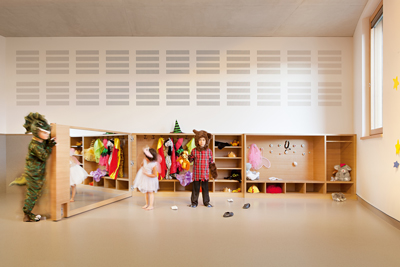You are in: Home page > Magazine Archive > Architecture and Pedagogy

Modus Architetti, School Center in Bolzano, Primary School, expressiveness laboratory, picture of Hannes Meraner
The metaphor of the body uncovers a number of ways in which a cross-disciplinary approach between the two fields of architecture and pedagogy could promote a learning environment of wellbeing in the design of educational facilities. By imagining the school as a body, the school is posited as a whole, living organism, whose constituent parts need to work together to achieve a healthy balance . Wellbeing is also attributed to the capacity of an individual to adapt to challenges and this statement could arguably hold true to buildings themselves. As such, the resiliency of schools in the face of radically shifting pedagogical models are also discussed. By tracing the physical dimension, or that which is corporeal, in the architecture and the pedagogical content in schools, the remarkable commonalities between the two disciplines come to light and provide interesting insight into how changes in didactic practices can affect the school buildings and vice versa.
Umberto Galimberti’s double reading of the body as that which can inhabit, and that which in itself is inhabited, allows us to understand the centrality of the human body in where we are, and in all that we do. More specifically, in the field of pedagogy, the relationship between learning and the body is subject to much debate. Various figures in the field of pedagogy (in Italy) such as Massa in 1986, Ulivieri in 2000, Gamelli in 2001, and Mariani in 2004, have referred to the body as a pedagogical apparatus that is inscribed into any form of learning: the body is understood as the conflation of both knowledge and space whereby knowledge is activated by the body in physical space.
In the essay entitled “Il corpo tra formazione e scuola” (“The Body between Education and School”) Alessandro Mariani describes the school as being at a crossroads. On the one hand, the “Gentiliana” tradition continues to maintain its ground with its cognitive approach of “observing, monitoring and documenting” which marginalizes or distances students from their own education by the very fragmentation and isolation of the respective parts of the body: the head, the eye and the hand. On the other hand, the slogan “a scuola con il corpo” (“to school with the body”) embodies the 20th century spirit whereby the fragmentation of knowledge is rejected in favor of a more holistic, “whole body” approach to the “making of education.” This divide between traditional and contemporary approaches to education is frequently summed up in the binary between “passive learning” and “active learning” with each offering very different modes of engaging the body. Current trends in innovation in the school focus not only on active learning practices, but also underline the importance of the well-being of both teachers and students alike and together create a more explicit, corporeal dimension to learning and learning environments.
The constituent parts of the architecture of a school move from a seemingly literal interpretation of the schools as a body—the face/the façade, the skeleton/the structure—to move onto the more intangible and haptic aspects of school environments whereby perception and learning intermingle in the uncharted, overlapping territory of architecture and pedagogy.














